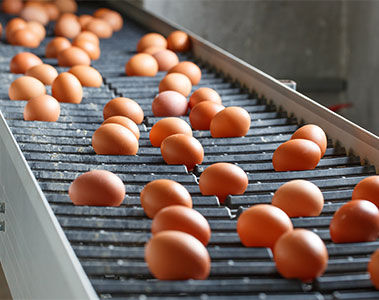
-
Global/EN
- Global
- North America
- Latin America
In order for a yolk to present an attractive golden color, carotenoids have to:
Therefore the hen, the environment and the feed have to work in concord to deliver an attractively pigmented yolk. In nature, the male birds with the best coloration will attract the females. This makes sense, because only the healthier individuals will be able to obtain appealing feathers. The same goes for the females: the healthier hens will have more carotenoids for their eggs. So, in order to have a golden yolk, you need a good-quality feed, the correct husbandry practices and - more importantly - a healthy hen.
The egg yolk pigmenting efficiency of carotenoids is determined by two main factors: egg yolk deposition rate and carotenoid color (wavelength).
Deposition of dietary carotenoids in the egg yolk depends on the individual carotenoid molecule (Figure 1). As the content of carotenoids in the feed increases, their concentration in the egg yolk rises in direct proportion. works especially well in wheat-based broiler diets and can save $3–$6/tonne feed
The wavelengths of the colors of the carotenoids used for egg yolk pigmentation fall between 400 nm and 600 nm within the visible range of the color spectrum.
To the human eye, such compounds are yellow to red in color. Lutein, zeaxanthin and apo-ester are yellow carotenoids (wavelength from 445 to 450 nm), whereas canthaxanthin is a red carotenoid (wavelength from 465 to 470 nm).
There are two components of egg yolk pigmentation. The first (referred to as the saturation phase) involves the deposition of yellow carotenoids to create a yellow base corresponding to a dsm-firmenich YolkFan™ score around 7. Such a yellow base is very important for good saturation of the final color. Once the yellow base is established, the addition of the red carotenoid canthaxanthin (CAROPHYLL® red) changes the hue to a more orange-red color (the second component, or color phase). The dose-related color response to red carotenoids is higher than the response to yellow carotenoids, and the combination of yellow and red carotenoids is therefore more cost-effective for egg yolk pigmentation. Figure 3 illustrates this principle.
Regarding the relative pigmenting efficiencies of the yellow carotenoids, apo-ester (CAROPHYLL® yellow) is more efficient than lutein and zeaxanthin, the main carotenoids in feedstuffs. The very high deposition rate of apo-ester (CAROPHYLL® yellow) makes it the most suitable yellow carotenoid for the saturation phase. Table 1 below shows the relative pigmenting efficiency of yellow carotenoids (based on deposition rates).
The dsm-firmenich YolkFan™ provides a simple means of measuring yolk color. However, attention should be paid to the following factors during the procedure:
First set the dsm-firmenich YolkFan™ score. If you choose 12/13, most of your eggs will fall between these two scores.
Refer to table 3 and calculate the amount of xanthophyll contained in the ingredients used in the formulation; and to finish, review table 4 to know how much CAROPHYLL® yellow and red is needed to obtain the required dsm-firmenich YolkFan™ score.
Example: the target dsm-firmenich YolkFan™ score is 13. The feed contains 15% yellow corn, 2% corn gluten (60%) and 1% DDGS. Table 3 shows that the yellow xantophyll content of this feed is 6 ppm.
At this point, you can use least cost formulation or use table 5 to fix the required levels of CAROPHYLL® yellow and CAROPHYLL® red.
An example of a possible least cost formulation:
To obtain a dsm-firmenich YolkFan™ score of 13, you need 10.5 ppm of yellow carotenoids (yellow base). Following the example from Table 3, we have to add 4.5 ppm of yellow carotenoids on top of the feed content (10.5-6). When using Apo-ester, we divide this amount by 3 (Table 1), reflecting its higher pigmenting efficacy. Therefore, we have to add 1.5 ppm of Apo-ester (15 ppm of CAROPHYLL® yellow 10%) and 4 ppm of Canthaxanthin (40 ppm of CAROPHYLL® red 10%).
To succeed in any yolk pigmentation program, it is important to measure. For more than five decades, the dsm-firmenich YolkFan™ has been the standard on yolk pigmentation measuring technology. It went from a few blades back in the sixties, to the newer version with 16 blades launched in 2016. By customers request, the YolkFan™ evolved in to the digital YolkFan™ Pro allowing data handling capabilities, multi-device monitoring and measurement of other poultry products like skin or tarsos. The device is connected to any smartphone via a user friendly App that is available in the two most common operating systems and allows small size, portability and most importantly: objective measurement with no light, observer bias or interference. The digital era in poultry pigmentation technology.
Visit the digital YolkFan™ Website: here.
Of course, the classic YolkFan™ is still available as a practical resource for a quick color check.
Many years of experience in carotenoid chemistry have given dsm-firmenich the expertise to manufacture CAROPHYLL® products of exceptional quality.
CAROPHYLL® yellow 10% and CAROPHYLL® red 10% are free-flowing, granulated carotenoid products. They consist of small beadlets in which the carotenoid is finely distributed in a starch-encapsulated plant and carbohydrate matrix to which antioxidants have been added, making CAROPHYLL® products animal-free.
The special manufacturing process, known as ‘spray-dried coating’, protects the carotenoids against oxidation and gives them high stability, water dispersability, outstanding mixing properties, and very good absorption characteristics.
27 May 2021
Fernando Cisneros is the Global Layer Solutions Lead. He holds a PhD (University of Illinois) and a MSc (UNAM, Mexico) on animal nutrition, and a BSc on Veterinary Medicine (U. Metropolitana, Mexico).
Fernando was a researcher (INIFAP) and then was hired by Roche Vitamins as technical manager in Mexico and Canada, account and sales manager for dsm-firmenich Canada, before his current global role. He is passionate about egg quality, bright food and the sustainability of animal farming.
We detected that you are visitng this page from United States. Therefore we are redirecting you to the localized version.